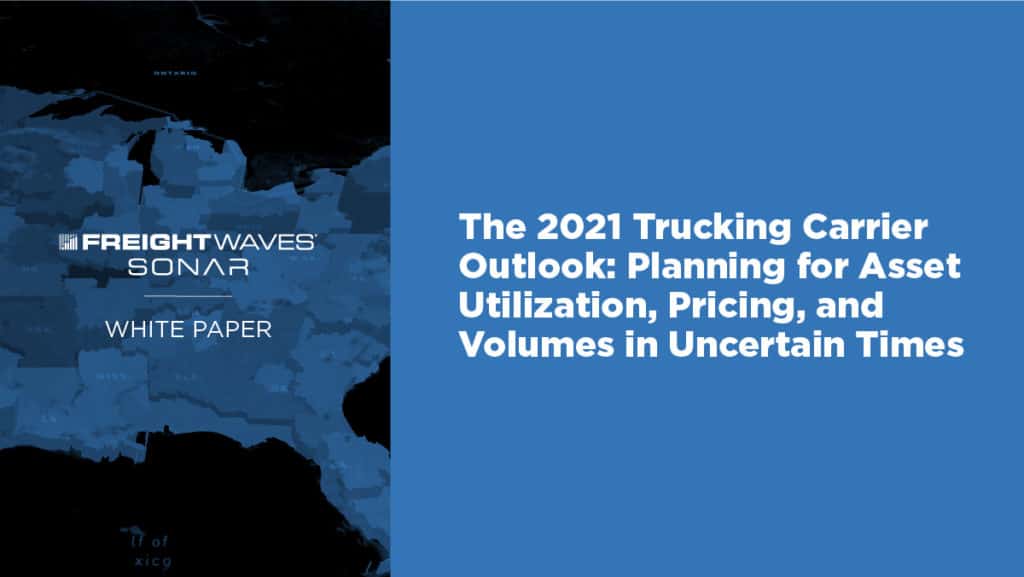The state of logistics in 2021 continues to undergo transformation and disruption (continued from 2020), and while companies are looking for new logistics strategies to stay proactive, there comes a point at which supply chain leaders need a simple, fast way to view market conditions. That’s especially true for organizations looking to manage e-commerce. Remember that the unprecedented demands of e-commerce have also added pressure on shippers to find capacity throughout all industries. Meanwhile, those same effects carry over into carrier responsibilities to strategically allocate assets. Note, however, that the ability to apply data depends on the actionability of information. That’s where freight indices come into play.
These factors are further seen in top-industry trends. As reported by Supply Chain Digest, “Online shopping is rapidly increasing as a share of retail sales, creating new demands for faster and cheaper delivery of goods straight to consumers. This trend is changing land use patterns and contributing to increased truck traffic and competition for curb space in residential areas. Emerging technologies from automation to delivery drones to the Internet of Things have the potential to transform the freight industry, disrupting old business models and changing the nature of freight jobs.” Clearly, the need for technology is absolute. And national freight indices are helping all freight management segments boost pricing strategies and understand how to better prioritize their operations.
The most advanced freight indices leverage real-time, historic and invoiced freight data to provide more insight into all operations and enable strategic competitive advantages. As examples, the characteristics of SONAR indices have helped to build the reputation of the SONAR freight forecasting platform and include:

All freight management segments can deploy a mix of various indices’ insight to understand different aspects of their operation. For instance, trucking KPIs and related benchmarking metrics can be viewed as a way to measure overall profitability for brokers and carriers.
| Segment | Tendering | Resource Utilization | RFP and Onboarding | Strategic Growth |
|---|---|---|---|---|
| Broker | Offer the right rates to carriers |
Move assets based on demand |
Use data to align RFP quotes to market conditions & seasonality | Enable strategic growth with the right carrier & shipper network |
| Carrier | - Set rates to avoid losses - Know when and where to reject loads |
- Move assets based on demand - Offer more competitive rates for equipment/driver |
- Increase driver hiring processes - Create competitive rate schedules in RFP responses. - Enter new lanes |
- Add lanes - Avoid overspend - Plan routes - Consolidate freight - Take advantage of backhauls |
| Shippers | - Increase acceptance rate - Lower freight spend |
Avoid overscheduling or overambitious tendering practices | Increase carrier/broker relationships to secure more capacity | Enable future-proof growth strategies, including all supply chain needs |
| Analysts | Understand current tendering practices | Recognize hot versus cooling markets | Provide more concise, accurate consultancy services | Stay informed with up-to-date data and insights |
Any strategy for deploying a freight market index should also consider a simple fact; data grows in value as its variety and detail expand. In other words, data insights through an index within one mode may very well be valuable for additional data-driven transportation management decisions throughout your whole network, not only in trucking. As an additional example, consider these other FreightWaves SONAR indices and their relative modes.
| Freight Segment | SONAR Feature 1 | SONAR Feature 2 | SONAR Feature 3 | SONAR Feature 4 |
|---|---|---|---|---|
| Drayage-Focused Shippers, Carriers & Brokers | Ocean Shipments Report | U.S. Port Market Share | Top 100 Import Consignees Report | TEU Volume |
| Carriers’ Preferred Indices | OTVI/ITVI | OTRI/ITRI | ALL TCA BENCHMARKING INDICES | |
| Rail Indices | ORAIL.USA & IRAIL.USA | ORAILMS & IRAILMS | ORAILDOM.USA | |
| Air Indices | OARIVOL IAIRVOL | Drewry Air Freight Rates (DAIR) | AIRUSD, AIREUR & AIRLOC |
|
Access to data and national freight indices are essential tools in a freight manager’s tech stack. However, the level of granularity must also include a drill-down ability to view the various indices that go into overarching market insights. In other words, the real value of any index depends on the ability of freight management parties to apply that information in local and national markets. And fortunately, SONAR has already taken the initiative by creating that functionality within its lineup of indices and continuing advancements as part of SONAR SCI. Learn more about how to get started by requesting a FreightWaves SONAR demo via the button below.
